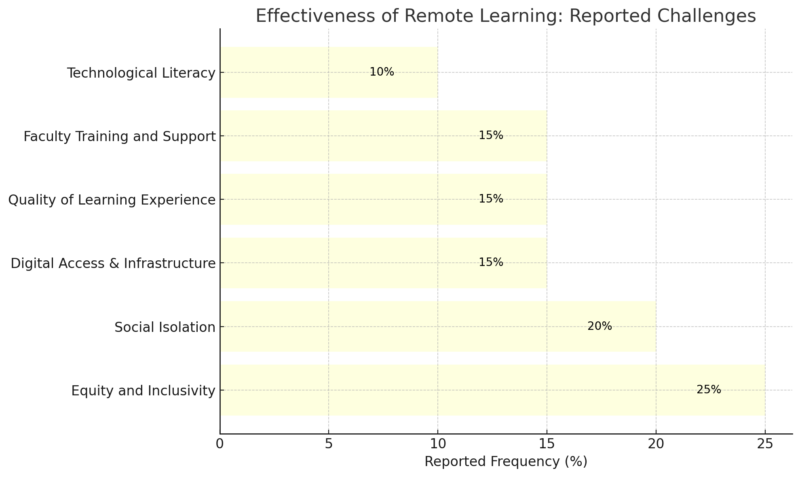Online education has rapidly evolved from an optional learning method to a global necessity, particularly after the COVID-19 pandemic.
As internet access expands and digital platforms become more advanced, online education now reaches more learners than ever before.
However, despite its convenience and flexibility, online education does not automatically guarantee equal access for all.
The core issue is this: While online education creates opportunities, it simultaneously deepens existing educational inequities.
Students from underdeveloped regions, lower-income households, and marginalized communities face barriers such as limited internet access, lack of devices, inadequate infrastructure, and underqualified teaching.
Unless addressed systematically, these gaps will continue to widen.
Regional Disparities and Uneven Resource Distribution

Access to quality education through digital platforms is unevenly distributed, heavily influenced by regional economic development, infrastructure, and policy support.
Students in urban, well-funded areas benefit from better connectivity, advanced learning tools, and expert educators.
In contrast, rural and less developed regions often struggle with outdated equipment, unreliable internet, and a shortage of qualified teachers.
Comparison of Online Education Access by Region
Region Type
Internet Access
Teacher Availability
Device Accessibility
Urban (Developed)
High
High
High
Rural (Underserved)
Low
Low
Low
To narrow these disparities, the government must enhance investments in infrastructure, especially in rural and underserved communities.
Policies should incentivize private platforms to extend their services to disadvantaged regions.
Educational NGOs and community-based programs also play a vital role in bridging the accessibility gap through donations, device drives, and local training initiatives.
Technology Gap and Digital Barriers
View this post on Instagram
Technology access remains a fundamental barrier to equitable online learning. Students without access to stable internet, smart devices, or technical support are effectively excluded from digital classrooms.
Furthermore, individuals with limited digital literacy are often unable to navigate learning platforms effectively.
Key Challenges
Solutions
By addressing the digital divide through comprehensive tech support, more learners can meaningfully participate in online education.
Government Policy and Investment

As policymakers and funders, governments have the unique capacity to influence digital infrastructure, regulatory standards, and resource allocation. Addressing the structural barriers that perpetuate inequality begins with policy frameworks that prioritize inclusion.
First, targeted investment in under-resourced areas is crucial. Governments should prioritize expanding broadband access in rural and underserved urban communities where connectivity remains unreliable or unaffordable.
Beyond infrastructure, public funding should also support device distribution programs, enabling students from low-income households to access laptops, tablets, or mobile-compatible learning resources.
Second, governments must enforce national standards for online education. This includes establishing curriculum guidelines, teacher qualification benchmarks, and learner protection policies.
By creating a centralized quality assurance mechanism, ministries of education can reduce the variation in course quality across institutions and platforms.
Third, teacher training is an often-overlooked but vital component of digital education reform. Governments should subsidize teacher professional development programs focused on digital pedagogy, technology integration, and student-centered approaches to online learning.
Key Areas of Government Policy Support
Policy Area
Action Required
Internet Infrastructure
Expand affordable broadband in rural and low-income communities
Device Access
Fund device distribution programs for students in need
Curriculum Regulation
Enforce national standards for online course design and delivery
Teacher Professional Development
Provide training subsidies for digital teaching competencies
Support for Marginalized Groups
Allocate special funding for schools serving disadvantaged populations
Through deliberate and well-funded policies, governments can close the digital gap and ensure that all students have access to meaningful and high-quality online education.
Institutional Responsibilities: Schools and Educators
Their responsibilities go beyond content delivery; they must build internal systems that guarantee consistency, quality, and responsiveness in the digital learning environment.
The foundation of institutional responsibility lies in teacher preparedness. Institutions should regularly invest in training programs to strengthen faculty capacity for online instruction.
These programs should cover digital content creation, the use of learning management systems (LMS), virtual classroom facilitation, and assessment strategies suited for online learners. Moreover, institutions should actively partner with universities and research bodies to stay aligned with evolving educational methodologies and technologies.
In addition to training, institutions must develop effective systems for quality control. A formal teaching evaluation framework, including peer reviews, student feedback, and periodic audits, is essential to maintaining high standards.
Institutions should monitor student performance data to identify gaps in teaching effectiveness and adapt course structures accordingly.
Equally important is learner support. Schools must provide timely academic counseling, tech support, and mental health resources tailored to the challenges of remote learning.
Personalized learning plans, progress-tracking tools, and virtual tutoring can all contribute to better academic outcomes.
Institutional Strategies for Equitable Online Learning
Focus Area
Implementation Strategy
Teacher Development
Offer ongoing digital pedagogy training, workshops, and peer mentoring
Quality Assurance
Use structured evaluation systems and integrate student feedback mechanisms
Learner Support
Provide academic advising, online counseling, and IT assistance
Research Collaboration
Engage with educational research bodies for evidence-based improvements
By creating robust internal systems and placing learners at the center of their digital strategy, educational institutions can help level the playing field and ensure equal opportunities for academic success.
Role of Online Education Platforms
@amandamelrose You can find full reviews of all of these programs plus more on my YouTube channel! #homeschooling #homeschool #homeschoolmom #homeschoolers #homeschooler ♬ original sound – eSchooled with Amanda Melrose
Their design, reach, and operational strategies can either mitigate or magnify educational inequities. To promote inclusive learning, platforms must adopt proactive strategies that prioritize accessibility, content quality, and personalization.
One of the foremost responsibilities of platforms is to expand their geographic and demographic reach. Collaborating with governments and NGOs, platforms should focus on delivering services to underserved regions and communities. This may include low-cost or subsidized course offerings, offline access to materials, and localized content in regional languages.
Content quality is another critical dimension. Platforms should enforce strict internal standards for course design, ensuring material is up-to-date, academically rigorous, and engaging. Additionally, platforms must verify the qualifications of educators and subject matter experts, maintaining accountability through performance monitoring and user ratings.
Inclusivity in design is also essential. Courses should be optimized for low-bandwidth environments and mobile devices, and they must incorporate features like captioning, screen reader compatibility, and flexible pacing options to support diverse learners, including those with disabilities.
Personalized learning pathways powered by data analytics can further enhance student engagement. Using AI, platforms can assess learner behavior, recommend content, and identify areas needing reinforcement.
Platform-Based Strategies for Promoting Equity
Strategic Area
Implementation Tactics
Geographic Reach
Localize content, partner with NGOs and governments, offer free/low-cost access
Content Quality
Set internal standards, verify instructor credentials, use learner performance data
Inclusive Design
Provide multilingual support, screen reader access, and mobile-friendly interfaces
Personalization Tools
Use AI-driven analytics for customized learning experiences
Feedback Mechanisms
Collect student feedback to continuously improve content and delivery
Case Study Analysis
The data from six higher learning institutions in Lusaka reveals critical equity-related barriers that impacted the effectiveness of remote learning.
Among the most frequently reported challenges were:

The most pressing issue identified was equity and inclusivity (25%), underscoring that students from disadvantaged backgrounds—such as those with limited access to technology, stable internet, or supportive learning environments—were disproportionately affected.
This aligns with global concerns that remote learning can deepen pre-existing inequalities when not supported with inclusive strategies.
Social isolation (20%) ranked second, emphasizing how the lack of face-to-face interaction and campus-based social structures impacted student engagement, mental health, and overall academic motivation. This indicates that digital learning environments must do more to foster community and peer-to-peer interaction.
Digital access and infrastructure (15%) and technological literacy (10%) point to logistical limitations many students and staff face. Inadequate access to devices and internet connectivity hindered both learning and teaching.
While the issue was reported by a slightly smaller percentage, its systemic nature means it likely contributed to several of the other challenges, such as lower engagement and reduced instructional quality.
Lastly, faculty training and support (15%) highlighted a key institutional gap.
Remote teaching requires new pedagogical strategies and technical proficiency, yet many lecturers were unprepared for this shift, limiting their ability to adapt content and support students effectively.
Interpreting the Opportunities
Despite the challenges, respondents identified several opportunities presented by remote learning:

Remote learning eliminated geographical and physical barriers, allowing students from rural or underserved areas to attend university without needing to relocate or incur additional costs.
This is a critical finding—it demonstrates that, when infrastructure and support are in place, remote learning can be a powerful tool for inclusion.
Enhanced technological skills (20%) was the second-highest opportunity. Students and faculty had to quickly adapt to using digital tools and platforms, which improved their digital literacy—a vital skill in today’s workforce and an indirect benefit of the remote learning shift.
Other notable benefits included flexibility and continuity.
Students were able to balance education with personal or professional responsibilities more effectively.
Furthermore, the ability to maintain academic programs during lockdowns or disruptions added institutional resilience to the higher education sector.
However, opportunities like personalized learning (10%) and collaborative learning (5%) were reported less frequently.
This suggests that, while possible, those benefits were not fully realized in practice. It may reflect a lack of adaptive learning technologies or the limited use of group-based instructional design in remote settings.
Conclusion
Remote learning, while necessary and beneficial in many contexts, has exposed and deepened pre-existing inequities in education.
Students from marginalized backgrounds face greater challenges, including limited digital access, weak support systems, and poor engagement.
However, with the right investments in infrastructure, training, inclusive content, and support services, institutions can narrow the digital divide and ensure that remote education benefits all learners—not just those with privilege.
Equity in education must remain a top priority in any digital transformation strategy.

